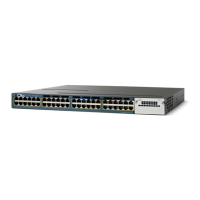1-26
Catalyst 3750-X and 3560-X Switch Software Configuration Guide
OL-25303-03
Chapter 1 Configuring DHCP Features and IP Source Guard
Displaying IP Source Guard Information
The output shows the five valid IP-MAC bindings that have been learned on the interface Fa0/3. For the
private VLAN cases, the bindings are associated with primary VLAN ID. So, in this example, the
primary VLAN ID, 200, is shown in the table.
Switch# show ip verify source
Interface Filter-type Filter-mode IP-address Mac-address Vlan
--------- ----------- ----------- --------------- ----------------- ----
Gi1/0/3 ip trk active 40.1.1.23 200
Gi1/0/3 ip trk active 40.1.1.24 200
Gi1/0/3 ip trk active 40.1.1.20 200
Gi1/0/3 ip trk active 40.1.1.21 200
Gi1/0/3 ip trk active 40.1.1.22 200
Gi1/0/3 ip trk active 40.1.1.23 201
Gi1/0/3 ip trk active 40.1.1.24 201
Gi1/0/3 ip trk active 40.1.1.20 201
Gi1/0/3 ip trk active 40.1.1.21 201
Gi1/0/3 ip trk active 40.1.1.22 201
The output shows that the five valid IP-MAC bindings are on both the primary and secondary VLAN.
Displaying IP Source Guard Information
Understanding DHCP Server Port-Based Address Allocation
DHCP server port-based address allocation is a feature that enables DHCP to maintain the same IP
address on an Ethernet switch port regardless of the attached device client identifier or client hardware
address.
When Ethernet switches are deployed in the network, they offer connectivity to the directly connected
devices. In some environments, such as on a factory floor, if a device fails, the replacement device must
be working immediately in the existing network. With the current DHCP implementation, there is no
guarantee that DHCP would offer the same IP address to the replacement device. Control, monitoring,
and other software expect a stable IP address associated with each device. If a device is replaced, the
address assignment should remain stable even though the DHCP client has changed.
When configured, the DHCP server port-based address allocation feature ensures that the same IP
address is always offered to the same connected port even as the client identifier or client hardware
address changes in the DHCP messages received on that port. The DHCP protocol recognizes DHCP
clients by the client identifier option in the DHCP packet. Clients that do not include the client identifier
option are identified by the client hardware address. When you configure this feature, the port name of
the interface overrides the client identifier or hardware address and the actual point of connection, the
switch port, becomes the client identifier.
In all cases, by connecting the Ethernet cable to the same port, the same IP address is allocated through
DHCP to the attached device.
The DHCP server port-based address allocation feature is only supported on a Cisco IOS DHCP server
and not a third-party server.
Table 1-3 Commands for Displaying IP Source Guard Information
Command Purpose
show ip source binding Display the IP source bindings on a switch.
show ip verify source Display the IP source guard configuration on the switch.

